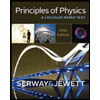
Concept explainers
An object is observed to fall from a bridge, striking the water below 2.50 s later, (a) With what velocity did it strike the water? (b) What was its average velocity during the fall? (c) How high is the bridge?
(a)
The velocity with which the object falling from a bridge strikes the surface of the water after
Answer to Problem 17PEB
Solution:
The velocity with which the object strikes water is
Explanation of Solution
Given data:
The time of travel of water from the bridge to the surface of water is
Formula used:
Write the expression for average acceleration.
Here,
Write the expression for the change in velocity.
Here,
Explanation:
Refer to the expressions for average acceleration and change in velocity. Combine both the expressions and write the expression for average acceleration in terms of initial and final velocity.
Consider the motion of the object from the bridge to the surface of the water. The object falls from the bridge and strikes the surface of the water after
Substitute
Further, solve.
Here, since the gravitational acceleration always acts in the downward direction, therefore, the sign of acceleration is negative. Also, the negative value of final velocity denotes the final velocity is in the downward direction.
Conclusion:
The magnitude of final velocity with which the object strikes water is
(b)
The average velocity of the object during its fall.
Answer to Problem 17PEB
Solution:
The object’s average velocity during the fall is
Explanation of Solution
Given data:
The magnitude of initial velocity and final velocity of the object are
Formula used:
Write the expression for the average velocity.
Explanation:
The magnitude of initial velocity and the final velocity of the object during the fall are
Substitute
Here, only magnitude is taken because direction is not necessary to calculate average velocity. The negative value of final velocity denotes its direction but to find the average velocity, only the magnitude of velocity is needed and thus, the negative sign is not taken.
Conclusion:
The average velocity of the object during the fall is
(c)
The height of the bridge from the water surface.
Answer to Problem 17PEB
Solution:
The bridge is at a height of
Explanation of Solution
Given data:
The average velocity of the object during its fall is
Formula used:
Write the expression for the average velocity in terms of distance and time.
Here,
Explanation:
The average velocity during the fall of the object from the bridge to water is
Substitute
Further, solve for
Conclusion:
The height of the bridge is
Want to see more full solutions like this?
Chapter 2 Solutions
Physical Science
- A soccer player kicks a rock horizontally off a 40.0-m-high cliff into a pool of water. If the player hears the sound of the splash 3.00 s later, what was the initial speed given to the rock? Assume the speed of sound in air is 343 m/s.arrow_forwardA ball is thrown straight up in the air. For which situation are both the instantaneous velocity and the acceleration zero? (a) on the way up (b) at the top of its flight path (c) on the way down (d) halfway up and halfway down (e) none of the abovearrow_forwardThe driver of a car slams on the brakes when he sees a tree blocking the road. The car slows uniformly with an acceleration of 5.60 m/s2 for 4.20 s, making straight skid marks 62.4 m long, all the way to the tree. With what speed does the car then strike the tree?arrow_forward
- Compare the distance traveled of an object that undergoes a change in velocity that Is twice its initial velocity with an object that changes its velocity by four times its initial velocity over the same time period. The accelerations of both objects are constant.arrow_forwardIf a car is traveling eastward, can its acceleration be westward? Explain.arrow_forwardTwo stones are thrown vertically upward at the same time, one with an initial velocity of 32 ft/s from a height of 128 ft, the other with an initial velocity of 64 ft/s from a height of 80 ft. If the stones travel along parallel paths, when will the second stone overtake the first?arrow_forward
- A ball is thrown vertically upward with an initial speed of 26 m/s, how long will it take for the ball to return to the thrower?arrow_forwardA car accelerates with a constant acceleration from rest to 30 m/s. It then continues at a constant velocity. Find Its acceleration. How far it travels while speeding up. The distance it covers while its velocity changes from 10 m/s to 20 m/s.arrow_forwardA stone is thrown from the top of a building with a velocity of 20 m/s straight upward. The building is 50 m high, and the stone just misses the edge of the roof on its way down. Determine (a) the time needed for the stone to reach its maximum height, (b) the maximum height, (c) the time needed for the stone to return to the level of the thrower, and (d) the velocity of the stone at this instant.arrow_forward
- a certain handgun with a muzzle velocity of 325 m/s is fired straight up. neglecting air resistance, how long will it take for the bullet to fall back to hit the shooter in the head?arrow_forwardA jet plane is launched from a catapult on an aircraft carrier. In 2.0 s it reaches a speed of 42m/s at the end of the catapult. Assuming the acceleration is constant, how far did it travelduring that 2.0 s?arrow_forwardDuring a hard sneeze, your eyes might shut for 0.38 s. If you are driving a car at 94 km/h during such a sneeze, how far does the car move during that time?arrow_forward
 Principles of Physics: A Calculus-Based TextPhysicsISBN:9781133104261Author:Raymond A. Serway, John W. JewettPublisher:Cengage Learning
Principles of Physics: A Calculus-Based TextPhysicsISBN:9781133104261Author:Raymond A. Serway, John W. JewettPublisher:Cengage Learning University Physics Volume 1PhysicsISBN:9781938168277Author:William Moebs, Samuel J. Ling, Jeff SannyPublisher:OpenStax - Rice University
University Physics Volume 1PhysicsISBN:9781938168277Author:William Moebs, Samuel J. Ling, Jeff SannyPublisher:OpenStax - Rice University

